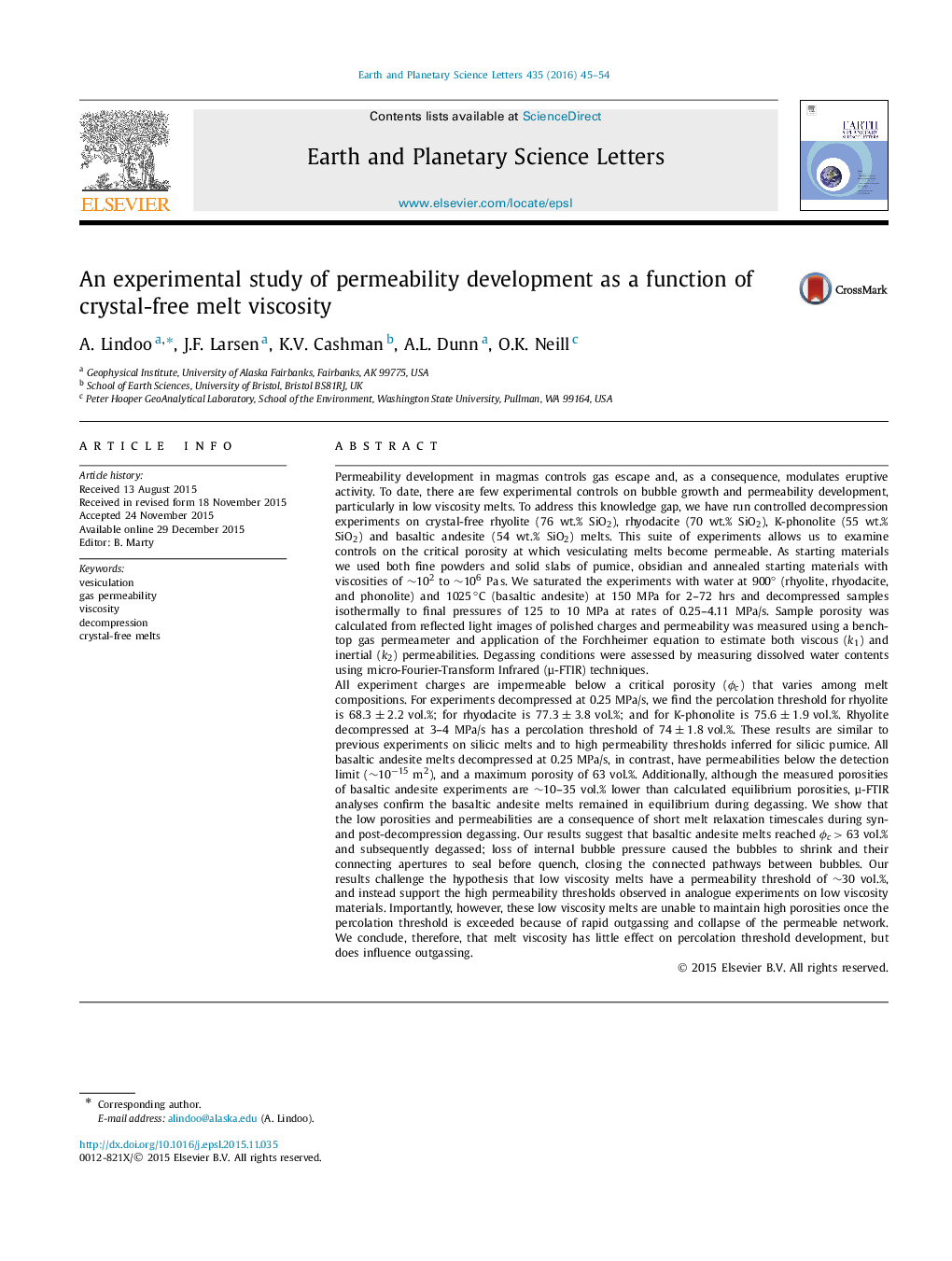| کد مقاله | کد نشریه | سال انتشار | مقاله انگلیسی | نسخه تمام متن |
|---|---|---|---|---|
| 6427636 | 1634721 | 2016 | 10 صفحه PDF | دانلود رایگان |
- Permeability development in crystal-free silicic, alkalic and mafic melts.
- Melt viscosities vary over four orders of magnitude (102 to 106.2Â Pas).
- Melt viscosity does not have an affect on the percolation threshold.
- Crystal-free melts require high melt vesicularities (>60 vol.%) to become permeable.
- Mafic melts outgas rapidly, showing porosity hysteresis at high ascent rates.
Permeability development in magmas controls gas escape and, as a consequence, modulates eruptive activity. To date, there are few experimental controls on bubble growth and permeability development, particularly in low viscosity melts. To address this knowledge gap, we have run controlled decompression experiments on crystal-free rhyolite (76 wt.% SiO2), rhyodacite (70 wt.% SiO2), K-phonolite (55 wt.% SiO2) and basaltic andesite (54 wt.% SiO2) melts. This suite of experiments allows us to examine controls on the critical porosity at which vesiculating melts become permeable. As starting materials we used both fine powders and solid slabs of pumice, obsidian and annealed starting materials with viscosities of â¼102 to â¼106 Pas. We saturated the experiments with water at 900° (rhyolite, rhyodacite, and phonolite) and 1025â°C (basaltic andesite) at 150 MPa for 2-72 hrs and decompressed samples isothermally to final pressures of 125 to 10 MPa at rates of 0.25-4.11 MPa/s. Sample porosity was calculated from reflected light images of polished charges and permeability was measured using a bench-top gas permeameter and application of the Forchheimer equation to estimate both viscous (k1) and inertial (k2) permeabilities. Degassing conditions were assessed by measuring dissolved water contents using micro-Fourier-Transform Infrared (μ-FTIR) techniques.All experiment charges are impermeable below a critical porosity (Ïc) that varies among melt compositions. For experiments decompressed at 0.25 MPa/s, we find the percolation threshold for rhyolite is 68.3±2.2 vol.%; for rhyodacite is 77.3±3.8 vol.%; and for K-phonolite is 75.6±1.9 vol.%. Rhyolite decompressed at 3-4 MPa/s has a percolation threshold of 74±1.8 vol.%. These results are similar to previous experiments on silicic melts and to high permeability thresholds inferred for silicic pumice. All basaltic andesite melts decompressed at 0.25 MPa/s, in contrast, have permeabilities below the detection limit (â¼10â15 m2), and a maximum porosity of 63 vol.%. Additionally, although the measured porosities of basaltic andesite experiments are â¼10-35 vol.% lower than calculated equilibrium porosities, μ-FTIR analyses confirm the basaltic andesite melts remained in equilibrium during degassing. We show that the low porosities and permeabilities are a consequence of short melt relaxation timescales during syn- and post-decompression degassing. Our results suggest that basaltic andesite melts reached Ïc>63 vol.% and subsequently degassed; loss of internal bubble pressure caused the bubbles to shrink and their connecting apertures to seal before quench, closing the connected pathways between bubbles. Our results challenge the hypothesis that low viscosity melts have a permeability threshold of â¼30 vol.%, and instead support the high permeability thresholds observed in analogue experiments on low viscosity materials. Importantly, however, these low viscosity melts are unable to maintain high porosities once the percolation threshold is exceeded because of rapid outgassing and collapse of the permeable network. We conclude, therefore, that melt viscosity has little effect on percolation threshold development, but does influence outgassing.
Journal: Earth and Planetary Science Letters - Volume 435, 1 February 2016, Pages 45-54
